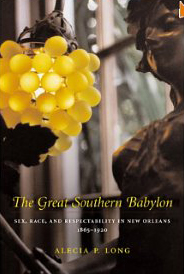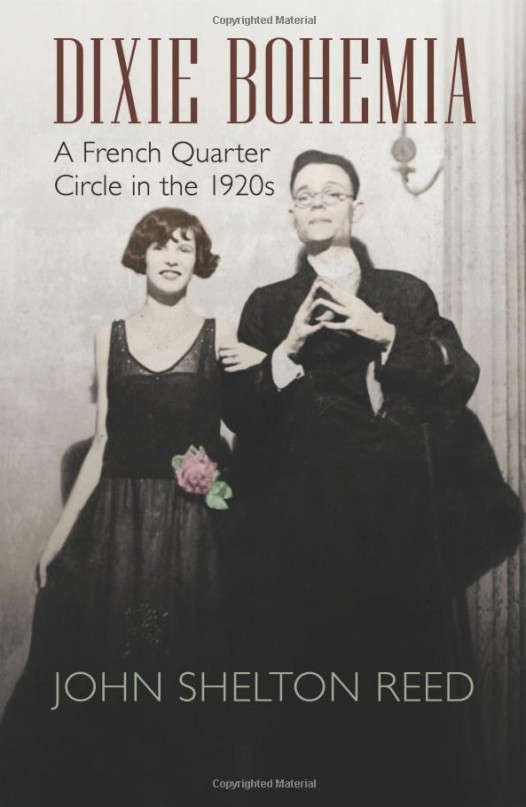 That was the money quote at Friday’s Tennessee WIlliams Festival session on “New Orleans in the 1920s: Bohemia, Baby Dolls and Storyville,” from panelist Alecia Long, author of The Great Southern Babylon: Sex, Race and Respectability in New Orleans, 1965-1920, along with fellow panelist John Shelton Read’s pun about serious works of non-fiction suffering from colon:itis. Delving as far as an hour and a half allowed into the world of prostitution and the original Baby Dolls – all sex workers who broke the convention against woman masking at the time – it was Read’s somewhat drier but headline-fresh description of the birth, brief flowering and decay of New Orleans as a bohemian center to rival Greenwich Village that was headline-fresh for Orleanians watching the struggle over gentrification along the river.
That was the money quote at Friday’s Tennessee WIlliams Festival session on “New Orleans in the 1920s: Bohemia, Baby Dolls and Storyville,” from panelist Alecia Long, author of The Great Southern Babylon: Sex, Race and Respectability in New Orleans, 1965-1920, along with fellow panelist John Shelton Read’s pun about serious works of non-fiction suffering from colon:itis. Delving as far as an hour and a half allowed into the world of prostitution and the original Baby Dolls – all sex workers who broke the convention against woman masking at the time – it was Read’s somewhat drier but headline-fresh description of the birth, brief flowering and decay of New Orleans as a bohemian center to rival Greenwich Village that was headline-fresh for Orleanians watching the struggle over gentrification along the river.
Read described the cohort of young artists and writers who came to New Orleans to create in the French Quarter “a vest pocket Greenwich Village [where] living was cheap and the neighbors tolerant.” Writers such as Pulitzer Prize-winner Oliver Lafarge, Sherwood Anderson and a young William Faulkner were among those who settled for a spell into the then run-down Quarter, and Anderson entertained visitors including Theodore Dreiser, Alice B. Toklas, Gertrude Stein, and Bertrand Russell.
 What fascinated about his presentation was his almost anthropological dissection of the rise and fall of Bohemias, from the first artists who arrive in search of local color and cheap living, the Beatnik-like hangers-on and slumming Uptowners who soon follow, until the French Quarter in particular was an attraction for “Uptown ladies and tourists” and one writers’ description of the neighborhood at the end of Bohemia’s blossoming would sound familiar to today’s visitors: “stale beer, garbage, drunks and tourists.”
What fascinated about his presentation was his almost anthropological dissection of the rise and fall of Bohemias, from the first artists who arrive in search of local color and cheap living, the Beatnik-like hangers-on and slumming Uptowners who soon follow, until the French Quarter in particular was an attraction for “Uptown ladies and tourists” and one writers’ description of the neighborhood at the end of Bohemia’s blossoming would sound familiar to today’s visitors: “stale beer, garbage, drunks and tourists.”
The tea shops established by the original Bohemians for their own pleasure became popular with visitors, Le Petite Salon brought book-club ladies from Uptown and Le Petite Theatre was founded; the original writers and artists found themselves being pushed out by rising rents and less congenial neighbors. Read details all of this in his book Dixie Bohemia: A French Quarter Circle in the 1920s.
The pre-1920s French Quarter would surprise local residents, but not the bohemian settlers of the period. Bourbon Street was a family block filled with working class people, largely Italian, and the remnants of old Creole families. Royal Street was the center of licentiousness, lined with clubs and served as bars, gambling dens and houses of prostitution combined, and even the now staid-Hotel Monteleone serviced the trade that brought to the quarter. New Orleans after the turn of the 19th century was changing, with high-rise buildings going up across Canal Street, and a new sense of boosterism sought not only to drive sin out of the quarter, but even threatened to demolish much of it for a new civic center, the only remnant of which is the old Municipal Auditorium.
Storyville, Long tells us, was a compromise. There was too much money to be made off of the “below the neck pleasure business,” as much if not more from alcohol sales as from prostitution, and much of that found its way into the pockets of the city and its employees, down to the cops lucky enough to draw that beat. Relocating the vice industry into a single district a bit further away from downtown was the solution, although Long reminds us the district stood directly behind the old Krauss and not two blocks from the Maison Blanche department stores, and would have abutted right up to the planned civic center running from Treme Street all the way to Royal.
 Storyville finally fell victim to the ultra-conservative war-time Federal government, which decreed that no troops could be stationed in a city with a sanctioned red-light district. Not that the business went away entirely – ”you can make prostitution illegal but you can’t make it unpopular,” Long quotes an unnamed politician – it simply moved into other parts of town. The famed district met its final end when most of it was demolished for the Iberville Housing Project.
Storyville finally fell victim to the ultra-conservative war-time Federal government, which decreed that no troops could be stationed in a city with a sanctioned red-light district. Not that the business went away entirely – ”you can make prostitution illegal but you can’t make it unpopular,” Long quotes an unnamed politician – it simply moved into other parts of town. The famed district met its final end when most of it was demolished for the Iberville Housing Project.
There are vestiges of the old sex workers still alive in New Orleans culture today, thanks to the revival of the traditional of the Baby Dolls by Antoinette K-Doe. The original Baby Dolls, according to Kim Marie Vaz, author of “BABY DOLLS”: Breaking the Race and Gender Barriers of the New Orleans Mardi Gras Tradition, the original Baby Dolls were black sex workers of the era who marched with their “sporting gentlemen” (pimps) in contravention of the understanding that women did not mask in the streets, and in stark contrast to the more formal black carnival krewes that survive today with their elaborate and exclusive balls.
Invitations to those events were as sought after and hard to get as invitations to Rex in the white community, and the organizations were quite conservative. Today’s Young Men’s Illinois Club emerged as a breakaway from the original group, after the scandal of a married man escorting a young woman not his wife into the ball, much as today’s Krewe d’Etat grew out of a desire to parade among the younger generation of Momus, who rejected the old krewe’s decision to refuse to parade rather than integrate.
The original Dolls used none of the props seen today, no baby bottles or suckers. Instead they dressed in the finest clothes they could manage and paraded shamelessly through the streets, drinking and dancing all the way, escorted by their sporting gentlemen often attired as police. The latter is rather funny if you consider the relationship to the sex workers who were the original Dolls to the law. The revival of the Baby Dolls contributes another facet to New Orleans black carnival of fancy dress balls and Mardi Gras Indians.
All of the panelists books are available in the Festival Book Shop located in the Hotel Monteleone.
This article by Mark Folse is reposted from the writer’s blog, Odd Words, which is a content partner of NolaVie.
 NOLAbeings Multimedia artist Claire Bangser created NOLAbeings as a portrait-based story project that marries...
NOLAbeings Multimedia artist Claire Bangser created NOLAbeings as a portrait-based story project that marries...  Voodoo in New Orleans: Reviving history: New Orleans fortune telling This article takes a deep dive into the history of Voodoo in New Orleans, its hybridization with Catholicism, and its present-day place in the city's culture. The author visits fortune-tellers in the French Quarter, using their guidance as a tool for introspection rather than a deterministic predictor of the future. Through her experiences in New Orleans, the author feels a mystical connection to both the past and the future.
Voodoo in New Orleans: Reviving history: New Orleans fortune telling This article takes a deep dive into the history of Voodoo in New Orleans, its hybridization with Catholicism, and its present-day place in the city's culture. The author visits fortune-tellers in the French Quarter, using their guidance as a tool for introspection rather than a deterministic predictor of the future. Through her experiences in New Orleans, the author feels a mystical connection to both the past and the future. 